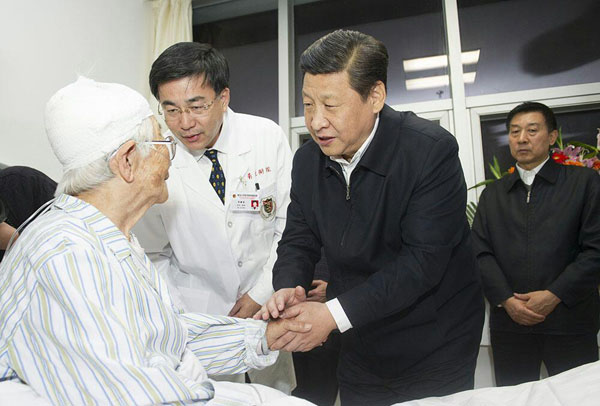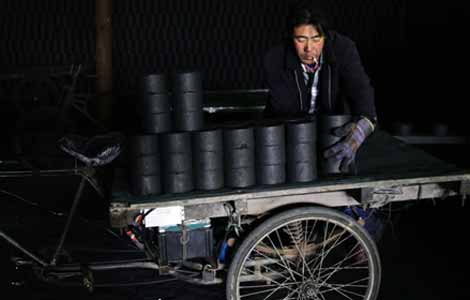Qingdao continues recovery
Updated: 2013-11-25 01:24
By He Na and Xie Chuanjiao in Qingdao, and Cui Jia and Tang Yue in Beijing (China Daily)
|
|||||||||||
President Xi Jinping says he feels sad at loss of life from the pipeline explosion.
As the death toll from Friday morning's explosion in Qingdao, Shandong province, rose to 52 on Sunday, officials ruled out the possibility of further blasts but said they will continue to monitor the situation closely.
Eleven people are still missing and 136 are receiving hospital treatment.
Officials said the blast happened when crude oil that had leaked from a ruptured pipeline ignited in storm drains in the Huangdao district.
City authorities had been concerned about the potential for further explosions because the force of the blast ruptured a number of pipelines in the area and buckled many others.
President Xi Jinping arrived in the city on Sunday afternoon to inspect the rescue efforts. After visiting blast victims at a hospital in Huangdao, he was given updates on the latest situation, according to reports on China Central Television on Sunday evening.
Xi said he was saddened by the loss of life and the devastation caused by the accident. He promised that the people responsible would be dealt with according to the law, and he pledged that people whose relatives had died or been injured would be compensated.
He said State-owned enterprises must take the lead in the "safe development" of Chinese industry and stressed that local governments should reject any project that poses a potential safety hazard to the general public. Xi also emphasized that officials should learn the lessons of previous accidents and said safety inspections must be carried out nationwide, especially on underground pipelines and networks.
The explosion blew a crater in the street about 30 meters in diameter and 6 meters deep. On Sunday, the rain poured as cranes lifted pieces of concrete about 20 cm thick from the crater, which was full of black wastewater mixed with crude oil. A strong smell of gasoline lingered in the air along Huangdao's 4-km main road, which was ripped apart by the blast.
Qingdao municipal government has ruled out the possibility of a terrorist attack, and said the economic damage to the area is still being assessed.
Complicated network
Friday's blast occurred at around 10:30 am, as workers were cleaning up fuel that had been spotted leaking from the pipeline more than seven hours earlier. Angry local residents are now asking why no official warning was given when the leak was initially discovered and why the pipeline was situated so close to a built-up area.
Under regulations that came into force in 2003, crude oil pipelines must be situated at least 15 meters away from public places and residential areas. They must also be at least 20 meters from factories and production areas.
However, in 2001, the Qingdao-based Peninsula Metropolis Daily reported that some buildings stand within 5 meters of the pipeline, which was laid in 1986 and predates the 2003 regulations. The residential section of Huangdao was built in the 1980s and 90s.
Guo Jishan, deputy secretary general of Qingdao municipal government, said that when it was laid, the pipeline conformed with the rules, but admitted that many pipelines run below Huangdao and they often overlap. "The pipeline system in Huangdao is very complicated — there are at least 11 different ones," he said.
Sinopec denied media reports that the 248-km-long pipeline, which runs across part of Shandong, from Dongying to Huangdao, was laid in August 2012.
The company said the pipeline was identified as a potential risk in 2011 and it plans to reroute five sections, including the 15 to 16 km running below Huangdao, plus two other pipelines in the province. However, it said the work has been stalled because the environmental impact of the plans is still under official assessment.
In a public announcement related to the first round of the environmental impact assessment in 2011, Sinopec said: "The area where the pipelines are located has become an extremely busy location, with many new buildings and a dense population. Some of the pipelines have been built over, making them inaccessible for repair and many of those we are able to reach are too close to buildings and it's difficult to maintain the erosion-resistant-layers. That makes them a potential safety hazard."
Sinopec conducted a nationwide safety inspection on an "unprecedented scale" in October, according to the company's website. Qingdao municipal government confirmed that the company inspected the pipeline at the center of Friday's tragedy, but was unable to give any further details.
Today's Top News
Premier Li heads west on opening-up tour
Deal reached in Iranian nuke talks
Roar of the East being heard
New air zone in line with practice
UN talks agree on major principles for climate pact
China maps out air defense ID zone
Nokia has 'phab' plan for Chinese mobile market
Newtown investigation report to be released
Hot Topics
Lunar probe , China growth forecasts, Emission rules get tougher, China seen through 'colored lens', International board,
Editor's Picks

|

|

|

|

|

|






